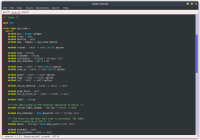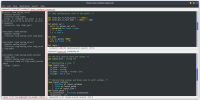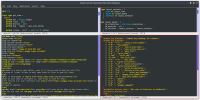Chamo is a source code editor, even if it can be used to edit any text file. A system of "views" allows to edit some kinds of files in specific views.
Each window can be splitted vertically or horizontally (à la emacs) or using tabs (à la gedit) in different views. Navigating from one view to another is easy with commands boundable to combinations of keys. One can also store the position and layout of the windows and the list of open files, so that, the next time Chamo is launched, everything is restored at the same position.
A "minibuffer" à la emacs with automatic completion is used to launch commands and indicate arguments for commands (when opening a file, doing some query/replace in a buffer, ...).
The text editing view uses OCaml-Stk sourceview widget and so provides the following functionalities: support of internationalisation (UTF-8), syntax highlighting (with colors, fonts, ...) depending on the language, undo/redo management, clipboard management, incremental forward/backward search, query/replace, history of pastable text ("kill-ring"), ...
A system of association of code to commands and of evaluation of commands
(in a form similar to shell commands
command arg1 arg2 ...)
allows to add one's own functionalities. It is also possible to add and modify
all key bindings, even specifically for each kind of view.
In the bytecode version of Chamo, the command eval takes in argument some OCaml
code which is interpreted and allows to modify everything in the editor: adding
modes, redefining commands, ..., the same way as with Lisp in Emacs. The command
eval_file interprets all the OCaml code present in a file given in argument.
split_horizontally (C-h or C-x 2 by default), split_vertically
(C-v or C-x 3 by default), destroy_active_view (C-x 0 by default).
cycle_tab (C-Tab by default) and new_tab
(C-x C-t by default)
allow respectively to move from one tab to another and create a new tab.
store_layout.
When the editor is launched in the same directory, position and layout of windows and views
are restored.
Various files are used to configure key bindings. Here is the default configuration file for all windows of Chamo. The key bindings of the active view are also configurable and are added to the common key bindings of windows.
File ~/.config/chamo/chamo.gui:
{ "window_key_bindings": "Common key bindings for windows", "window_key_bindings": [ ([ "C-x", "C-c" ], "close_active_window"), ([ "C-n" ], "new_window"), ([ "C-x", "C-s" ], "save_active_view"), ([ "C-x", "C-w" ], "save_active_view_as"), ([ "C-x", "C-f" ], "open_file"), ([ "C-b" ], "cycle_view"), ([ "C-Tab" ], "cycle_tab"), ([ "SC-Tab" ], "rev_cycle_tab"), ([ "C-x", "C-t" ], "new_tab"), ([ "C-v" ], "split_vertically"), ([ "C-x", "S-3" ], "split_vertically"), ([ "C-h" ], "split_horizontally"), ([ "C-x", "S-2" ], "split_horizontally"), ([ "C-x", "S-0" ], "destroy_active_view"), ([ "C-x", "C-x", "l" ], "print_key_bindings"), ([ "C-x", "v" ], "popup_pick_hidden_view"), ([ "C-x", "l" ], "pop_last_hidden_view"), ([ "C-y" ], "paste"), ([ "C-c" ], "copy"), ([ "C-w" ], "cut"), ([ "A-x" ], "prompt_command") ], "minibuffer_history_size": "The size of histories in minibuffer", "minibuffer_history_size": 50, "log": { "level": "log level", "level": "info", "length": "number of characters kept in log", "length": 200000, "font": "font for messages", "font": "fixed 10", "colors": { "warning": "color for warning messages", "warning": "orange", "info": "color for info messages", "info": "lightgreen", "error": "color for error messages", "error": "red", "debug": "color for debug messages", "debug": "yellow", "app": "color for app messages", "app": "white" } }, "abort_binding": "The key combination to use to reset the key stroke state", "abort_binding": "C-g" }




